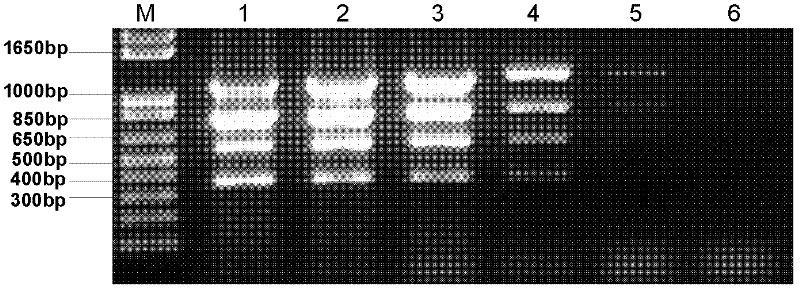Method for synchronous detection of sweet potato feathery mottle virus (SPFMV), sweet potato virus C (SPVC), sweet potato virus G (SPVG) and sweet potato virus 2 (SPV2)
A technique of synchronous detection and step method, which is applied in the direction of biochemical equipment and methods, microbial measurement/inspection, etc., can solve the problems affecting the accuracy of detection results, primers cannot distinguish SPFMV and SPVC, short detection cycle, etc., to achieve convenient long-term Time storage, convenient long-distance transportation, and the effect of saving reagent costs
- Summary
- Abstract
- Description
- Claims
- Application Information
AI Technical Summary
Problems solved by technology
Method used
Image
Examples
Embodiment 1
[0033] 1. Experimental materials
[0034] Single infection with sweet potato virus G (SPVG), sweet potato virus C (SPVC), sweet potato plume mottle virus (SPFMV), sweet potato virus 2 (SPV2) and co-infection with SPVG+SPVC, SPVG+SPFMV were confirmed by single RT-PCR , SPVG+SPV2, SPVC+SPFMV, SPVC+SPV2, SPFMV+SPV2, SPVG+SPVC+SPFMV, SPVG+SPVC+SPV2, SPVG+SPFMV+SPV2, SPVC+SPFMV+SPV2 and SPVG+SPVC+SPFMV+SPV2 greenhouse Sweet potato plants were used as materials, and healthy sweet potato plants were used as negative controls.
[0035] 2. Primer design and synthesis (synthesized by Invitrogen)
[0036] (a) Design and synthesize the universal reverse primer SPFCG2R for detecting SPFMV, SPVC, SPVG and SPV2: 5'-TCGGGACTGAARGAYACGAATTTAA-3', R=A or G, Y=C or T;
[0037] (b) respectively design and synthesize forward primers SPFF, SPCF, SPGF and SP2F for detecting SPFMV, SPVC, SPVG and SPV2, and the primer sequences are as follows:
[0038] SPFF: 5'-GGATTAYGGTGTTGACGACACA-3',
[0039] ...
Embodiment 2
[0056] 1. Experimental materials
[0057] The field susceptible sweet potato plants infected with SPVG, SPFMV alone and co-infected with SPVC+SPFMV, SPVG+SPFMV+SPV2, SPVC+SPFMV+SPV2 and SPVG+SPVC+SPFMV+SPV2 were confirmed by single RT-PCR as materials. Healthy sweet potato plants served as negative controls.
[0058] 2. Primer design and synthesis (synthesized by Invitrogen)
[0059] (a) Design and synthesize the universal reverse primer SPFCG2R for detecting SPFMV, SPVC, SPVG and SPV2: 5'-TCGGGACTGAARGAYACGAATTTAA-3', R=A or G, Y=C or T;
[0060] (b) respectively design and synthesize forward primers SPFF, SPCF, SPGF and SP2F for detecting SPFMV, SPVC, SPVG and SPV2, and the primer sequences are as follows:
[0061] SPFF: 5'-GGATTAYGGTGTTGACGACACA-3',
[0062] SPCF: 5'-GTGAGAAAYCTATGCGCTCTGTT-3',
[0063] SPGF: 5'-GTATGAAGACTCTCTGACAAATTTTG-3',
[0064] SP2F: 5'-CGTACATTGAAAAGAGAAACAGGATA-3',
[0065] Wherein, Y=C or T;
[0066] (c) The size of the fragment amplified b...
PUM
 Login to View More
Login to View More Abstract
Description
Claims
Application Information
 Login to View More
Login to View More - R&D
- Intellectual Property
- Life Sciences
- Materials
- Tech Scout
- Unparalleled Data Quality
- Higher Quality Content
- 60% Fewer Hallucinations
Browse by: Latest US Patents, China's latest patents, Technical Efficacy Thesaurus, Application Domain, Technology Topic, Popular Technical Reports.
© 2025 PatSnap. All rights reserved.Legal|Privacy policy|Modern Slavery Act Transparency Statement|Sitemap|About US| Contact US: help@patsnap.com



